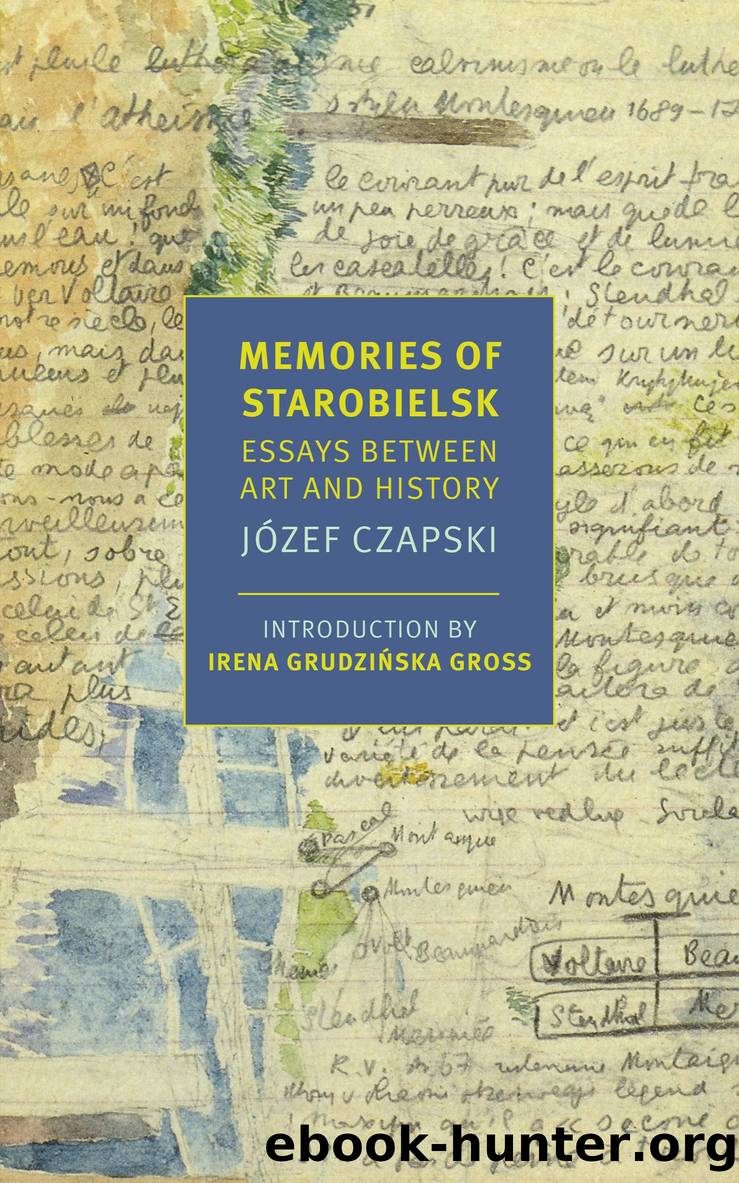Memories of Starobielsk by Jozef Czapski

Author:Jozef Czapski
Language: eng
Format: epub
Publisher: New York Review Books
Published: 2022-03-02T00:00:00+00:00
DERVISH
On Chaïm Soutine
Paris. The Occupation. Eighty-three Jewish painters are deported to camps by the Germans and murdered. Soutine goes into hiding in the nearby countryside. For several years he has had an intestinal ulcer. Cancer? A sudden deterioration. Rushed to the Junot clinic in Montmartre, operated on too late, he dies on August 9, 1943, exactly sixteen years ago. He is forty-nine. âGive me a shave, I donât want to enter the other world with a shaggy beard,â he is said to have yelled before he died.
Soutineâs first big exhibition in France (119 canvases from America, France, Switzerland, England) was undertaken by the Galerie Charpentier, not by an official institution, not one of the museums, whichâapart from the Petit Palais and the museum in Grenobleâdo not own a single painting of his.
In one of the glass cases at the exhibition a few pages are laid outâhis letters: Jâai décidé de rentrer à Chartres, je suis trop triste. . . . Je décidais de ne pas aller à lâinvitation de la femme écrivain, elle est trop embêtante.1 A very slanting hand, uncertain, and those strings of letters of uneven size, always sloping downward. Why do I have the impression from merely looking at these letters (I am not a graphologist) that it is the handwriting of a flayed man?
This exhibition was a revelation to me. I write that word with full consciousness of its weight. Soutineâs canvases have fascinated me for thirty years: his meats, the Boeuf écorché, the choirboys, the red groom at Chez Maxime. I discovered Goya after Soutine and perhaps thanks to Soutine. But today for the first time, looking at Soutineâs paintings, I had the impression that a good dozen painters of the first order, his contemporaries and mine, have now disappeared or rather receded to a level of lesser importance: Picasso, the royal tiger of our artistic circus; Braque, a precious poet, a connoisseur of form and color; even the art of the great Rouault, perhaps closest to Soutine, doesnât always have the same quality of color. In comparison with those of Soutine, some of Rouaultâs canvases seem impoverished, less anchored in a vision, more detached; they sometimes seem made with a cookie cutter.
We look at Soutineâs paintings cowedly, so exposed is he here: the hunger, the mud, the Jewish lice and fleas of Smilavichy, from where he had to flee, beaten by the sons of the rabbi because he had made a portrait of their fatherâa crime: âThou shalt make unto thee no graven image . . .ââSoutineâs studios in Paris, dirty, with dark, putrefying, foul-smelling pieces of meat, which he sprinkles with blood to âreviveâ themâportraits of people as if on a rack, children with innocent eyes, eviscerated geese, turkeys, ducks hung from hooksââI saw a butcher cut the throat of a goose and bloody it . . . I wanted to cry out, but the butcherâs gleeful look forced the cry back into my throat.â Soutine felt his throatââI feel that cry here
Download
This site does not store any files on its server. We only index and link to content provided by other sites. Please contact the content providers to delete copyright contents if any and email us, we'll remove relevant links or contents immediately.
Kathy Andrews Collection by Kathy Andrews(11730)
The remains of the day by Kazuo Ishiguro(8823)
Paper Towns by Green John(5091)
Spare by Prince Harry The Duke of Sussex(5072)
Industrial Automation from Scratch: A hands-on guide to using sensors, actuators, PLCs, HMIs, and SCADA to automate industrial processes by Olushola Akande(4983)
The Body: A Guide for Occupants by Bill Bryson(4974)
Machine Learning at Scale with H2O by Gregory Keys | David Whiting(4183)
Be in a Treehouse by Pete Nelson(3948)
Never by Ken Follett(3793)
Harry Potter and the Goblet Of Fire by J.K. Rowling(3775)
Goodbye Paradise(3728)
Into Thin Air by Jon Krakauer(3313)
The Remains of the Day by Kazuo Ishiguro(3294)
The Cellar by Natasha Preston(3262)
The Genius of Japanese Carpentry by Azby Brown(3226)
Fairy Tale by Stephen King(3220)
120 Days of Sodom by Marquis de Sade(3182)
The Man Who Died Twice by Richard Osman(2997)
Drawing Shortcuts: Developing Quick Drawing Skills Using Today's Technology by Leggitt Jim(2996)
